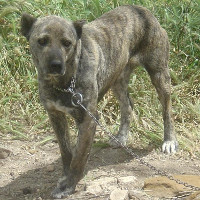 |
Dogo Sardo |
|
He is not recognized by the F.C.I. |
Origin |
Sardinia (Italy) | |
Translation |
Francis Vandersteen |
| Also known as Cani pertiatzu. A typical light Molossoid, with a square head and short muzzle that can sometimes be cone-shaped, and well-developed masseters. Being a working breed, its selection was based on the dog's utility, so that today there is a great phenotypic variety, but always due to the molossus light. Size can vary considerably from specimen to specimen and lineage to lineage, but on average is high at the withers (remember it must be lower than the croup) from 55 cm to 65 cm for 30-45 kg, has short hair (but not satin or even worse, shiny like the boxer, while dogs with matted hair or cinghialesco betray intersections with the dog fonnese). Fawn in various shades, wheaten (a rare color considered very typical and ancient), brindle in various shades, rare black and gray. Masseter muscles must be prominent and scissors or pincer-like teeth. Brachycephalic, with a pronounced occipital process. An excellent watchdog, it was and still is used on long hunting trips as a protection dog. Excellent as a retriever for Sardinian semi-wild cattle, bred wild in the mountains. In early 2000, dog expert Roberto Balia began writing up the results of years of study in our countryside in search of the Sardinian dogo (but not only, the Fonnese dog, the Sardinian greyhound and the Sardinian fox). Numerous high-quality articles in leading Sardinian newspapers aroused interest in the breed, and many specimens were made available to begin a serious selection process and avoid the danger of the ever-hidden labyrinth, given the presence of boxers and pit bulls. The turning point in the recovery process was the publication in 2005 of the book "Canis Gherradoris", also by Roberto Balia. Today, we can say that the breed, although rare, is no longer in danger of extinction. |






 English (United Kingdom)
English (United Kingdom)